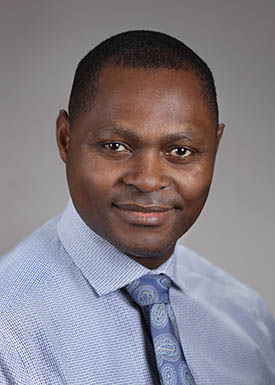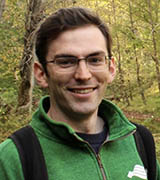Detecting and Fighting Transplant Rejection
Profile: Sean Agbor-Enoh, M.D., Ph.D.

Sean Agbor-Enoh
Lung transplantation is a complicated matter. On the one hand, it offers healthy lungs and a second chance to people with severe cystic fibrosis, chronic obstructive pulmonary disease, pulmonary hypertension, or other diseases that cause severe lung damage. On the other hand, organ rejection—a dangerous form of disease in which the transplant patient’s own immune system attacks their donor organ—is a major risk of a lung transplant. About half of lung transplants fail within five years, the highest failure rate of any transplanted organ.
This dilemma is something Sean Agbor-Enoh knows very well. During his medical training, he became aware that the standard method of detecting organ rejection—a tissue biopsy—was problematic. By the time a biopsy revealed that the organ was being rejected, it was often too late to save the lung. He has dedicated his career to finding better ways to prevent organ-transplant rejection. Today, he is a tenure-track NIH Lasker Clinical Research Scholar and an NIH Distinguished Scholar at the National Heart, Lung, and Blood Institute (NHLBI), where he heads the Lab of Applied Precision Omics (APO). In the APO lab, his research team is working to develop new ways to detect and treat transplant rejection.
The immune system is overly protective; it’s designed to respond to and eliminate foreign material that gets inside the body. Unfortunately, the immune system can’t always differentiate between the good intentions of a lung transplant and the bad intentions of bacteria such as, for example, the life-threatening Clostridium difficile. Immune system activation results in a flurry of antibodies streaming through the blood vessels, ultimately latching onto the cells that make up the transplant organ. The resulting tissue damage leads to transplant rejection, and eventually, organ failure. Medicine draws on immunosuppressive drugs to take the strength of the immune system down a notch, easing a transplant into a recipient’s body. Still, 50–75% of patients with transplant rejection die within two years after starting standard treatments using immunosuppressive drugs such as rituximab, which work by binding to and essentially nullifying the effect of the transplant-targeting antibodies.
Agbor-Enoh believes a large reason why patient outcomes are so poor is that the “gold standard” for diagnosis, tissue biopsy, is flawed. For one thing, tissue biopsy is expensive and invasive. It involves a surgical procedure to collect samples of tissue from the transplant organ. But more importantly, tissue biopsy often detects transplant rejection at an advanced stage of the disease when treatment is potentially less effective. “The biopsy that we are using now is enabling us to detect [transplant rejection], but detect it late when [the disease] is very advanced,” said Agbor-Enoh.
With Agbor-Enoh leading the APO Lab, one of its main focuses is donor-derived cell-free DNA (ddcfDNA), small strands of DNA that are released into the bloodstream by the donor organ when it is damaged by the transplant patient’s immune system. The patient has cfDNA as well, but its genetic sequence is different than that of the ddcfDNA, which allows the two to be differentiated from each other and quantified. Agbor-Enoh’s team has found that ddcfDNA can detect transplant rejection two to three months before a tissue biopsy can. “It is very sensitive,” said Agbor-Enoh. “As soon as you start having a few cells in that organ dying, the cell-free DNA test is already positive.”
Currently, his team has found that cfDNA sampled during the early period right after transplantation can predict 80–85% of the patients who will develop chronic rejection and die. In an article published in Circulation, Agbor-Enoh and colleagues sequenced the ddcfDNA of 165 heart-transplant patients (out of 171 participants). They found that cfDNA detects rejection 28 days before heart biopsy. Also, they estimated that by using cfDNA as a biomarker, physicians can safely avoid 81% of invasive heart biopsies. While tissue biopsies cost about $3,000–3,500, the cfDNA test costs about $150 per sample. (Circulation 2021; DOI:10.1161/CIRCULATIONAHA.120.049098).
The Atlantic Coast of Cameroon
Agbor-Enoh grew up in southwestern Cameroon near Mount Fako, an active volcano on the Atlantic coast. Being “so close to nature…really stimulates a lot of questions in your mind,” he said. He never intended to become a doctor but wanted to study soil, petroleum chemicals in particular. He had even been accepted to a Ph.D. program in England, but his family couldn’t afford the tuition. His father needed time to raise the money and suggested his son attend medical school for a year instead. In Cameroon, medical school was a far less expensive option—at the time it cost about $100 per year, some 1/500 the cost of studying petrochemicals in England. So, Agbor-Enoh followed his father’s advice and went to the University of Yaoundé (Yaoundé, Cameroon) to pursue a medical degree. His father was never able to raise the money for the Ph.D. program in England, and so his son reluctantly continued medical school.
But in his fourth year of medical school, things changed. Agbor-Enoh volunteered for a World Health Organization program to help distribute vaccines and medications in remote areas of Cameroon. He wound up in eastern Cameroon, an area without roads or hospitals. Sometimes, he had to walk 8–10 hours to reach the villages where he had to do his job with limited resources. One day, he treated the son of a village chief. The child likely had malaria and was dangerously anemic. “As I was holding the child and trying to figure out ways to get him to breathe, that child died,” said Agbor-Enoh. “It is that experience that made me commit to medicine. It made me go into research to try [to] solve problems, keep people healthy—and alive.”
Thinking in Parallels
As Agbor-Enoh was starting his medical career, he was intrigued by the parallels between the malaria parasite and an organ transplant. Both malaria parasites and transplanted organs have to adapt to living in different environments in order to survive. “If the organ fails to adapt, then the immune system of that host will kill it,” he said. In addition, he noticed the alarming rates at which transplant patients succumb to rejection. He saw transplantation medicine as a field with room for innovation and decided that it would be the area to focus on.
After completing medical school in 2002, Agbor-Enoh came to the United States to pursue a Ph.D. in molecular biology at Georgetown University Medical Center (Washington, D.C.), followed by an internal medicine residency at Johns Hopkins Bayview Medical Center (Baltimore). While at he was there, he also served as the chief resident in internal medicine. In 2012, he began a joint clinical fellowship in pulmonary and critical care medicine at the NIH Clinical Center (with Henry Masur) and Johns Hopkins Hospital.
Doctor Valantine is Calling
As Agbor-Enoh was finishing up the fellowships and trying to start a research career in transplantation, he received a phone call from Hannah Valantine, who was preparing to move from the Stanford University School of Medicine (Stanford, California) to NIH to start a lab at NHLBI and become NIH’s first chief officer for Scientific Workplace Diversity. At Stanford, Valantine had already been working on repurposing cfDNA to detect heart-transplant rejection. Agbor-Enoh had heard about fetal cfDNA being sampled from the blood of pregnant women to screen for genetic disorders such as Down syndrome. “I had heard about [cfDNA] before,” said Agbor-Enoh. “But never in the context of rejection or transplantation.” Valantine told him about her research plans with cfDNA and asked whether he’d like to become a staff scientist in her new transplantation genomics lab. He agreed on the spot and joined NHLBI in 2015.
Dr. Valantine “has just been a fabulous mentor to me,” said Agbor-Enoh. For Valantine and Agbor-Enoh, it was always clear he would eventually transition from staff scientist to lab chief. Under Valantine’s mentorship, Agbor-Enoh developed his own research mission with the plan of applying for the Lasker Clinical Research Scholars Program, which would give him the opportunity to start the APO Lab.
Planning Ahead
The Agbor-Enoh Lab’s mission is to improve lung-transplant survival by identifying and addressing gaps in lung-transplant care. As a first step, he is developing cfDNA as a tool to detect transplant rejection. His initial studies show that cfDNA only needs a blood draw and detects rejection up to two to three months before biopsy, the invasive method that is currently used. Developing such a tool for clinical use has its challenges and takes a lot of work. Currently, it takes about a week and a half from the time the sample is collected to the time the results are ready. Agbor-Enoh is trying to leverage digital-droplet polymerase chain reaction to reduce the turnaround time of the test. “If you can fix the issue with methods…it will make [the test] more clinically feasible,” said Agbor-Enoh.
Getting the cfDNA test into the hands of clinicians also requires validation by other labs in a large cohort of patients. Agbor-Enoh’s Scientific and Clinical Directors Robert Balaban and Richard Childs (NHLBI) have been great supporters. They share his vision and provide the resources to support the Genomic Alliance for Transplantation, which is a consortium of NHLBI and several heart-lung transplant programs at hospitals in the Washington, D.C., metropolitan area. By working together, the consortium’s goal is to do the necessary studies to get cfDNA ready for use in clinical care as quickly as possible. Agbor-Enoh is planning clinical trials to test whether cfDNA will improve patient outcomes by identifying transplant rejection earlier using cfDNA versus using tissue biopsies.
Occasionally, Agbor-Enoh invites his lung-transplant patients to his lab meetings to share their stories about lung transplantation and transplant rejection. In doing so, he hopes that the people in his lab “can continue to understand how valuable their work is in improving the lives of these unfortunate patients for whom lung transplantation is the only cure,” said Agbor-Enoh.
Sean Agbor-Enoh, M.D., Ph.D.
Lasker Clinical Research Scholar and NIH Distinguished Scholar; Head, Laboratory of Applied Precision Omics, National Heart, Lung, and Blood Institute
Education: M.D. from the University of Yaoundé (Yaoundé, Cameroon); Ph.D. in molecular biology from Georgetown University (Washington, D.C.)
Training: Fogarty International Fellowship and postdoctoral fellowship at Georgetown University Medical Center (Washington, D.C.); residency (and chief resident) in internal medicine, Johns Hopkins Bayview Medical Center (Baltimore); fellowship in critical care medicine, NIH Clinical Center; fellowship in pulmonary and critical care medicine, Johns Hopkins Hospital (Baltimore)
Came to NIH: In 2012 for a fellowship; joined NHLBI in 2015; became Lasker Clinical Research Scholar in 2020
Other positions: Instructor of Medicine, Johns Hopkins School of Medicine (Baltimore)
Notable recognition: In 2020, was named one of 1,000 Inspiring Black Scientists in America by Cell Mentor
Outside of Work: Explore nature’s treasures with his wife and four children, who range in age from 3 to 18.
Website: https://www.nhlbi.nih.gov/science/applied-precision-omics/people/agbor-sean
To learn more about Sean Agbor-Enoh and his work, visit the Office of NIH History’s “Behind the Mask Project” interview at https://www.youtube.com/watch?v=PqWryWkbo0o. To read a transcript of the interview, go to https://history.nih.gov/display/history/Agbor-Enoh%2C+Sean+2020.

Ethan Smith is a postbaccalaureate fellow in Jessica Gill’s lab in the National Institute of Nursing Research. His research involves studying biomarkers for traumatic brain injury. After completing his training at NIH, he plans to apply to graduate programs in clinical psychology. Outside of work he enjoys watching television, playing chess, and talking with friends.
This page was last updated on Monday, February 14, 2022
